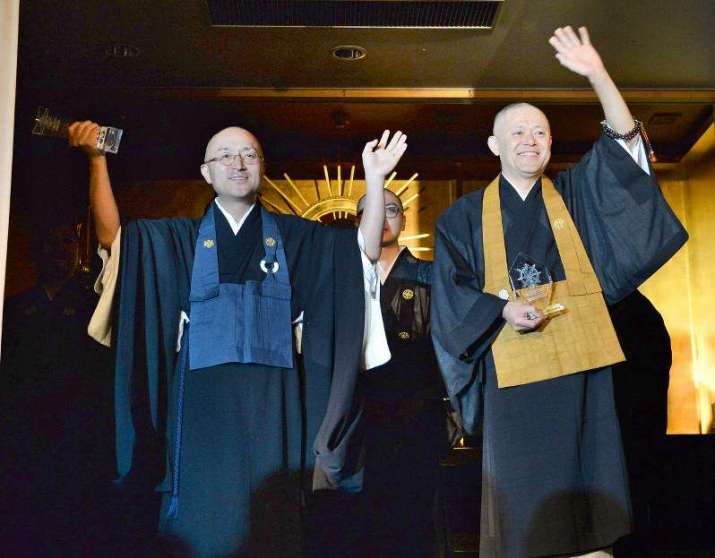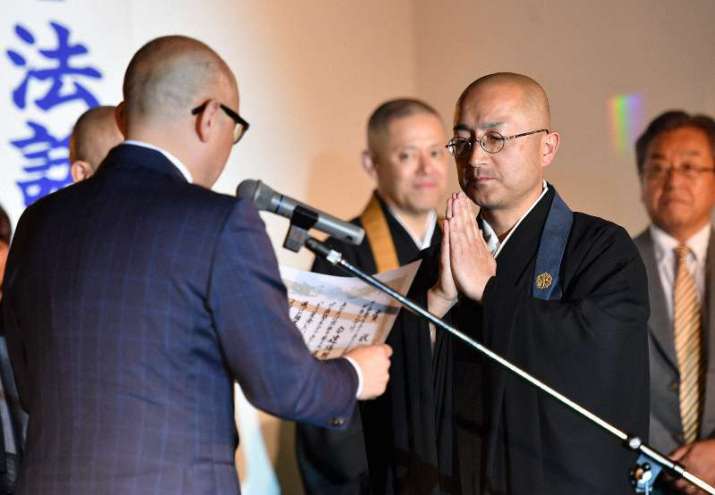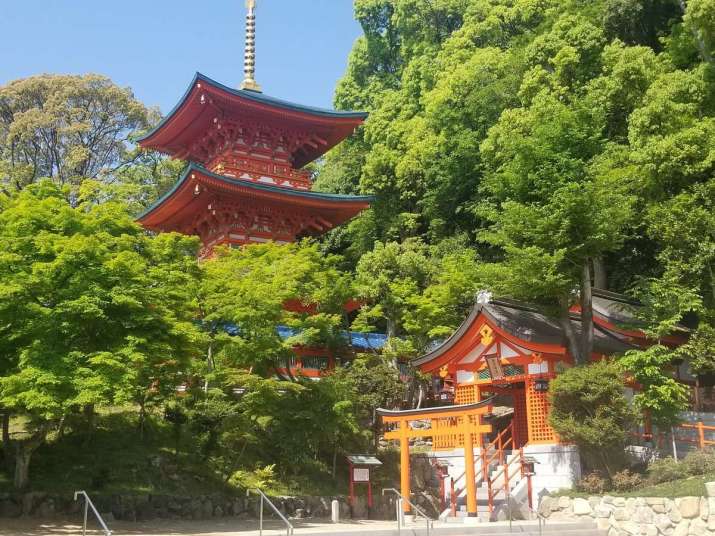NEWS
Monastics in Japan Compete in Intersectarian Contest to Communicate Buddhism
 Zuiju Adachi, left, winner of the Houwa Grand Prix, and judges' prize winner Shinkan Yamazoe. From mainichi.jp
Zuiju Adachi, left, winner of the Houwa Grand Prix, and judges' prize winner Shinkan Yamazoe. From mainichi.jpMonks from different Buddhist schools and regions in Japan came together on Sunday to deliver their houwa, or Buddhist lecture, at the “H1 Houwa Grand Prix.” The inaugural competition, sponsored by The Mainichi newspaper and other organizations, took place at the Suma-dera temple in Suma Ward, Kobe.
One of the purposes of the competition was to foster intersectarian friendship among the Buddhists of Japan. The chairman of the contest’s executive committee, Yonin Koike, 32, deputy chief priest at Suma-dera temple said that “I want to continue to convey an image of us going beyond our individual sects and joining hands to try to communicate Buddhism.” (The Mainichi)
The winner of the competition was Zuiju Adachi, 44, chief priest of Choraku-ji, a temple of the Soto Zen school in Tambasasayama, Hyogo Prefecture, in western Japan. A Jodo school monk from Kyoto, Shinkan Yamazoe, 50, was given a special judges’ prize.
 Zuiju Adachi receiving the grand prix for the first Houwa Grand Prix. From mainichi.jp
Zuiju Adachi receiving the grand prix for the first Houwa Grand Prix. From mainichi.jpThe competition featured eight individuals from seven different Buddhist schools. These included Shinshu Otani-ha, a school of Jodo Shinshu headquartered in Kyoto and with approximately 5.5 million members. Also represented was the Buzan ha, a school of Shingon founded in the 16th century by the priest Senyo Sojo, headquartered in Nara. Nichiren, one of the most popular schools of Buddhism in Japan, was also represented at the competition.
The contest utilized a variety of theatrical means, from singing in time to a keyboard performance, to using a kamishibai, a kind of picture-board storytelling. Each contestant tried to outwit the others in expressing the appeal of Buddhism to an audience of around 450 people. In the end, the winner was chosen by drawing votes from both the audience and a panel of five judges.
The winner, Adachi, prevailed with a lecture he entitled “Everyone who laughs is Kanon”—Kanon is the bodhisattva of compassion and mercy and serves at the principal image at Adachi’s temple. Adachi offered a tale about a temple cricket and the elementary school student who watched it regularly, keeping a diary of its activities. He said, “In our everyday existence, wouldn’t taking even a short amount of time to consider the importance of the life handed down to us bring a smile to our faces?” (The Mainichi)
 Suma-dera temple. From twitter.com
Suma-dera temple. From twitter.comTraditional forms of Buddhism have been in decline in Japan throughout the post-World War Two period of the 20th century. However adherence to Japanese Buddhism has been growing according to surveys of religion in Japan dating back to the 1980s. Today, Buddhism and Shinto are the two most widespread religious traditions in Japan. Recent scholars, such as Jason Ananda Josephson, have drawn out the difficulties of studying religion in Japan, noting that the Japanese word for religion, shukyo, is only a 19th century invention and that it does not properly cover the meaning that the word has in English.
Despite the strength of Buddhism in Japan at present and the rise in overall adherence, a 2015 report suggested that Buddhism in Japan may be reaching a point of crisis. As rural participation in temple life wanes, more than one-third of the nation’s temples may face closure by 2040.* Efforts like this week’s friendly competition between monks of varied sects aim to revitalize interest in Buddhism among the Japanese people.
* Almost One-third of Japan’s Buddhist Temples Expected to Close by 2040 (Buddhistdoor Global)
References
Josephson, Jason Ananda. 2012. The Invention of Religion in Japan. The University of Chicago Press.
See more
Lecture of laughs: Hyogo monk wins inaugural 'Houwa' Buddhist lecture prize (The Mainichi)
Related news from Buddhistdoor Global
Japanese Kannon Bodhisattva Statue Believed to Be Work of Celebrated 12th Century Sculptor Kaikei
Zen Buddhist Priest Offers Refuge to All Comers in Japan
Kyoto Temple Unveils Android Version of Kannon Bodhisattva
Buddhist Temple in Tokyo Offers Graves for LGBT Couples
Japanese Priest Serves Up Pure Land Buddhism with Techno Beats














